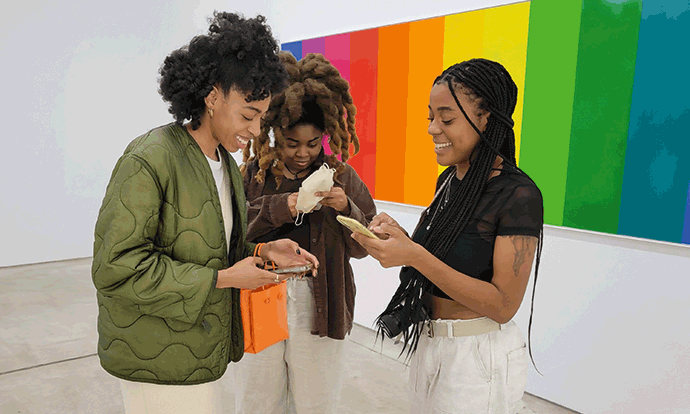Participants in a BGIAS meetup at a Hank Willis Thomas show in New York in 2022
Photo: Kimberly J
Black Girls In Art Spaces (BGIAS), a fast-growing community for Black women to explore the arts and champion Black artists, has expanded from an initial meetup at a Dallas art gallery to more two dozen chapters across the US and abroad in just two years.
“The most joyful part has been the connections and knowing that we’ve been an oasis for so many Black women,” said Kaci Merriwether-Hawkins, the founder of BGIAS. “It just makes you feel welcomed, and it connects you to your people. It’s unmatched to be able to connect with other women who look like you and who may have had similar experiences.”
The group began after Merriwether-Hawkins moved to Dallas in 2022 and was looking to make new friends.
“It was my first time being in a new space where it was more difficult to make connections,” Merriwether-Hawkins said. She had attended Tuskegee University in Alabama, a historically Black university that she describes as having a very tight-knit, close culture. She first fell in love with museums in 2020 after seeing Black Is Beautiful: The Photography of Kwame Brathwaite at the Columbia Museum of Art in her hometown in South Carolina, and particularly hoped to meet others interested in art and culture.
“I wanted to create a group where Black women could experience these art spaces together, something that was accessible, conversational and multi-generational,” Merriwether-Hawkins says.”
Merriwether-Hawkins held the first BGIAS event at Daisha Board Gallery, which at the time was Dallas’s only contemporary art gallery owned by a Black woman. Soon after, volunteers started their own chapters in New York, Washington, DC, and other cities. As of August 2024, around 30 BGIAS chapters have held events, including internationally in London, Nairobi, Seoul and Mexico City.
“This is a community garden. I planted the seed, and so many people have come along and poured into it,” Merriwether-Hawkins says. She attributes BGIAS’s fast growth to an active social media presence, as well as the clear name. (“The name alone is going to grab the right audience,” she says. “You don’t have to question who it is for. It’s been a magnet for people who align with the mission.”)
The typical BGIAS meetup sees the women have a private tour of an exhibition dedicated to work by a Black artist at a commercial gallery, museum or other art space, followed by a guided conversation about what they have just seen and then a meal together. Meetups can also consist of art-related workshops or talks. The majority of BGIAS events are free, with some select events being low-cost, Merriwether-Hawkins says. Events are open, but the group asks that all attendees identify as a Black woman, girl or nonbinary person. All ages are welcome, and many attendees bring their children.
The biggest challenge has been choosing the right groups and institutions to partner with, she says, and making sure they are inclusive in their work and aren’t tokenising the group or Black artists.
The art world is a notoriously exclusive place. An analysis by the journalists Charlotte Burns and Julia Halperin published in 2022 of nearly 350,000 acquisitions and 6,000 exhibitions at 31 US museums between 2008 and 2020 found grim divides in gender and race. Works by artists who identified as women counted for only 11% of acquisitions and 14.9% of solo and group exhibitions, while works by Black Americans made up 2.2% of acquisitions and 6.3% of exhibitions. The figures for Black American women artists were even more dire, with their work only comprising 0.5% of acquisitions, far below their 7.7% share of the US population, according to the US Census.
One of Merriwether-Hawkins’s favourite parts of the organisation is how varied participants’ backgrounds in the arts are. Some attendees have very little experience visiting galleries or museums, while others work professionally as curators or artists. Some have even made connections within the group to find jobs in the industry, Merriwether-Hawkins says.
As for the future of the group, Merriwether-Hawkins wants to continue reaching Black women who align with the group’s mission, as well as offer more educational opportunities, like seminars for curatorial training and classes on how to collect art.
“One thing I've really learned through building this community is that there are Black women who love art all over the world,” she said. “I want to be able to reach those people. That’s my number one goal.”

